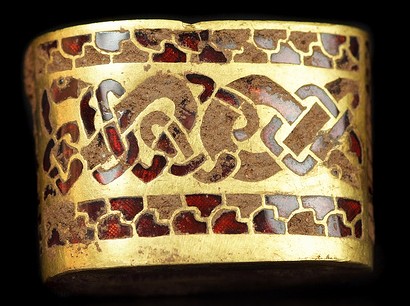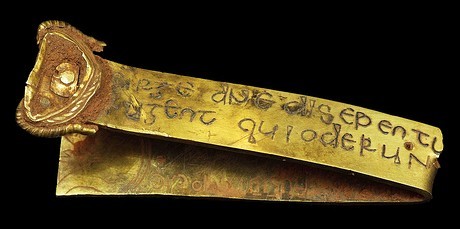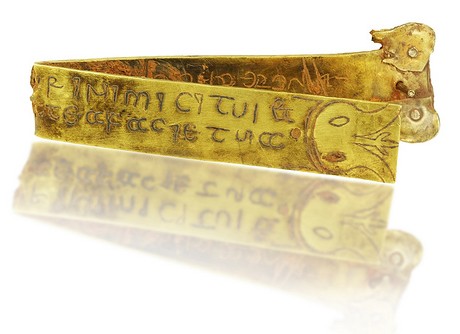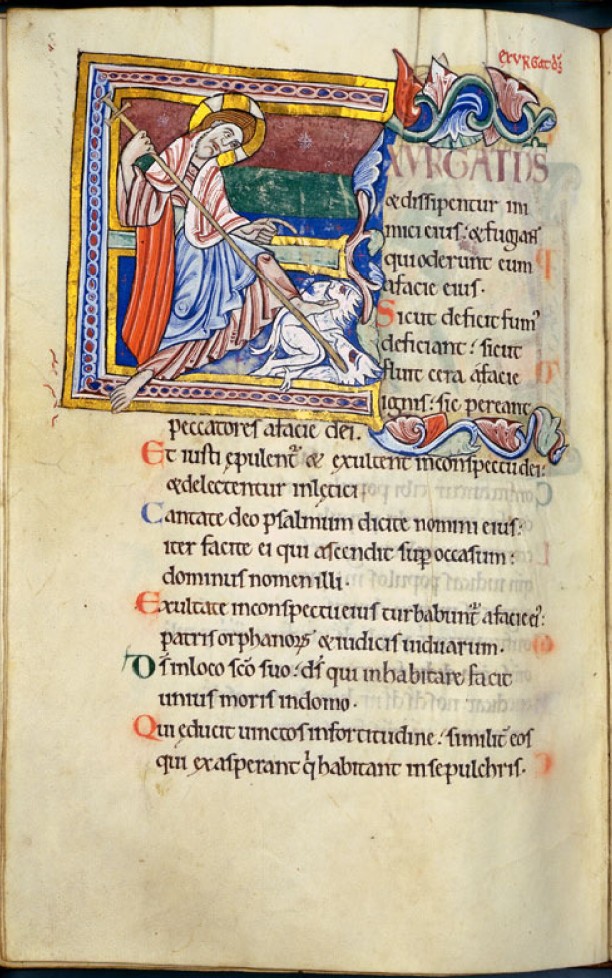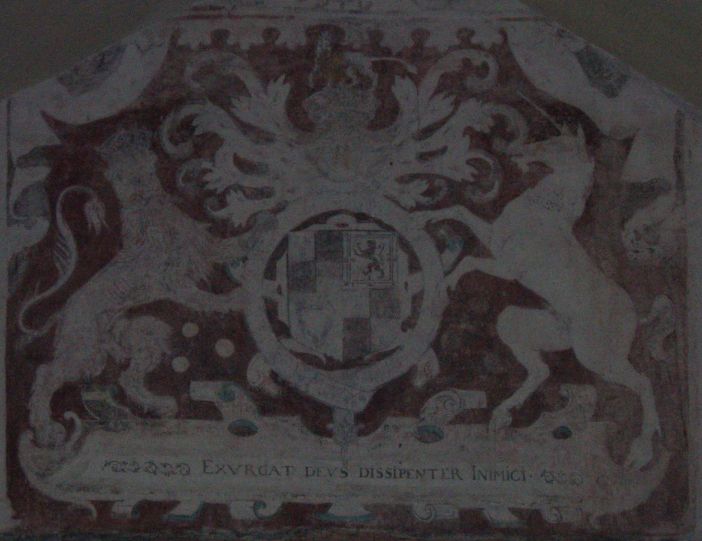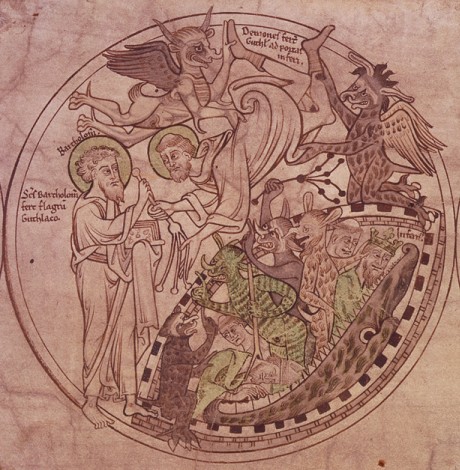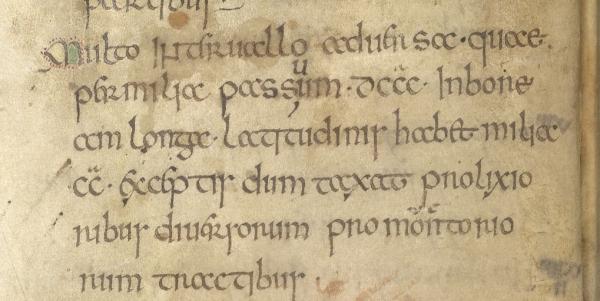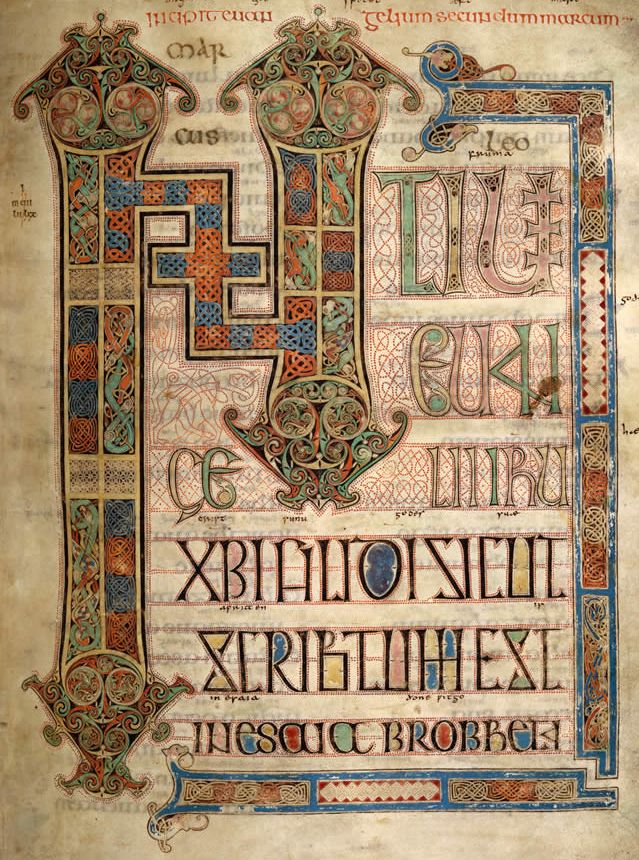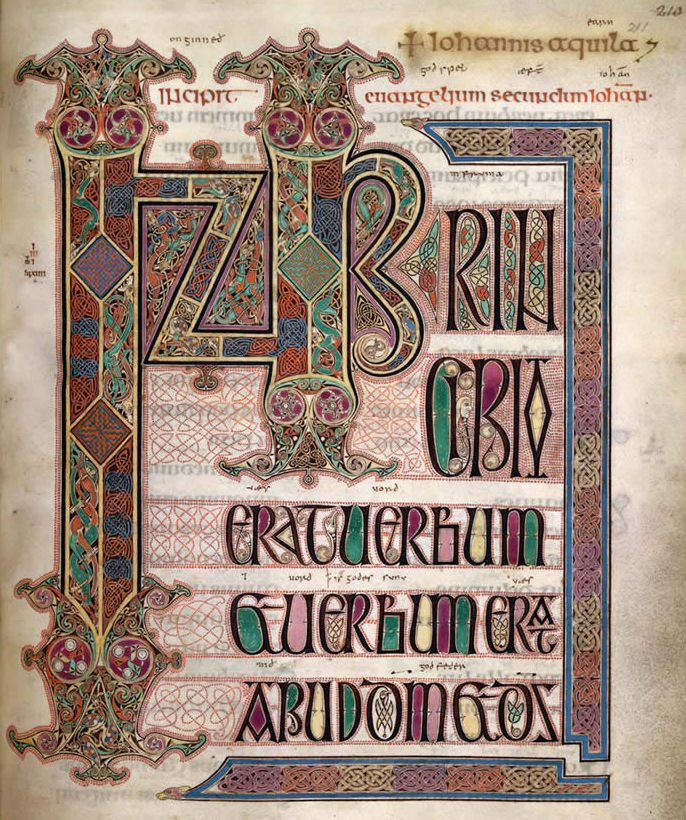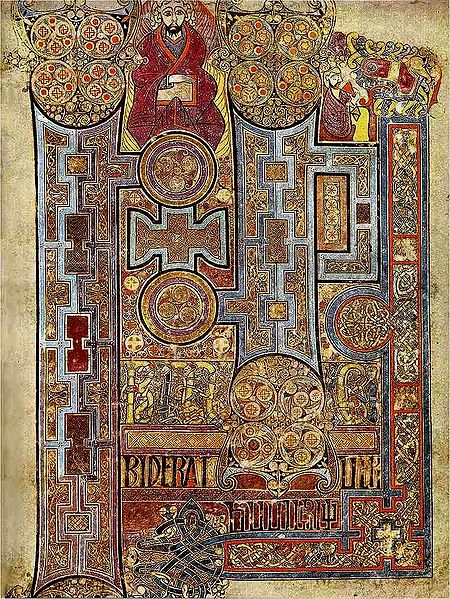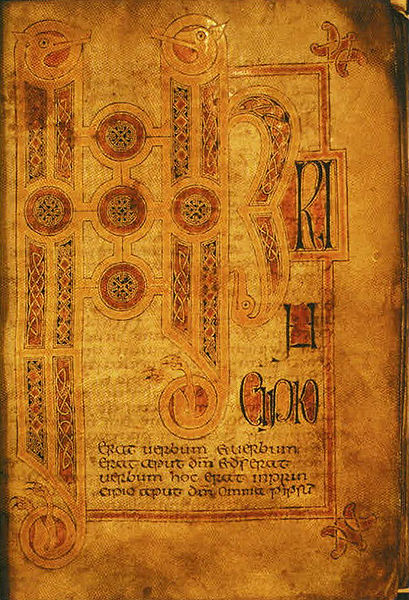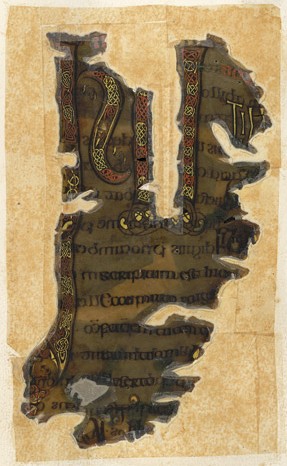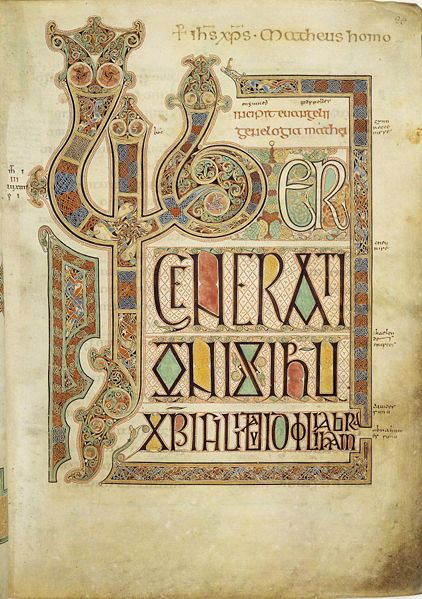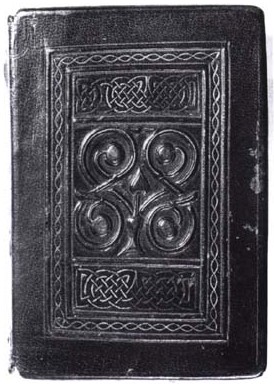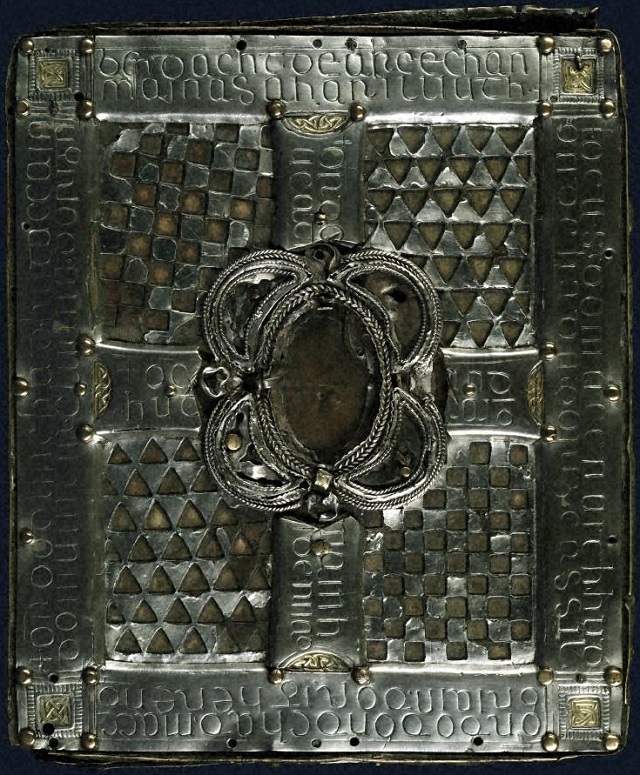BabelStone Blog
Friday, 25 December 2009
The Staffordshire Hoard : Anglo-Saxon Epigraphy and the Manuscript Tradition
The British archaeological discovery of the year must be the Staffordshire Hoard (which perhaps should better be known as the Hammerwich Hoard), which is a hoard of more than 1,500 Anglo-Saxon gold and silver items (tentatively dated to the 7th or 8th centuries) that were discovered on 5th July by a metal detectorist in a field just south of Watling Street, within the parish of Hammerwich, near the Roman staging post of Letocetum (the modern village of Wall in Staffordshire), within the bounds of the Anglo-Saxon kingdom of Mercia.
The majority of items are martial in nature, including sword fittings, such as hilt collars, hilt plates and pommel caps, as well as scabbard bosses and helmet cheek pieces. There appear to be no items of feminine jewellery, and only two or three religious pieces, including a folded gold cross, which has led Professor Nicholas Brooks to conclude that the contents of the hoard originally belonged to the Mercian court armourer. Others have suggested that the hoard is loot from from a battle (the valuable parts of swords and other pieces of armoury stripped off for ease of transport), speculatively loot taken by King Penda of Mercia after his defeat of King Edwin of Northumbria at the Battle of Hatfield Chase in 633 ... and for some reason buried next to the main road about twelve miles from the Mercian capital of Tamworth (see final paragraph for my theory that the hoard was buried in 757).
A Sword Hilt Fitting from the Staffordshire Hoard (NLM 449)
There are many beautiful pieces, but from my perspective the hoard might have been very much more interesting if it had included some sword blades, as Anglo-Saxon sword blades sometimes had Runic inscriptions engraved on them, but the hoard seems to have mostly comprised a collection of sword fittings.
ᚠᚢᚦᚩᚱᚳᚷᚹᚻᚾᛁᛄᛇᛈᛉᛋᛏᛒᛖᛝᛞᛚᛗᛟᚪᚫᚣᛠ
ᛒᛠᚷᚾᚩᚦ
1. An Enigmatic Gold Strip
Although, to my disappointment, there are no items with Runic inscriptions on them in the Staffordshire Hoard, there is one solitary piece, a gold strip folded in half (about 18 × 1.6 cm in size if unfolded), that has a biblical inscription in Latin letters engraved on both sides of it :
Gold Strip with a Biblical Inscription (NLM 550)
The only object from the Staffordshire Hoard with an inscription
It is not immediately obvious what this gold strip was used for, but the pin or rivet on the reverse of the empty jewel setting and the two holes (one in the middle and one at the other end from the jewel setting) indicate that it must have been attached to something else. It has been suggested that the gold strip might originally have been attached to a shield or to a sword belt, but Nicholas Brooks has advanced the theory that the gold strip is the arm of a cross: the jewel setting would have been at the terminal end, and the flat end would have been attached to the central, circular fitting of the cross. This is an interesting idea, but without seeing at least one other example of an Anglo-Saxon or Celtic cross with such a construction I do not find it wholy convincing. For one thing, if the end with the jewel setting is the terminal end of a cross-arm (perhaps the top arm, with the jewel at the top of the arm, as is the case with the folded gold cross), then what is the pin sticking out the back for ? (I present a different explanation for the gold strip at the bottom of this article.)
The inscription on the outside of the fold (what I will call the front side) can be read quite easily.
Inscription on the Front of the Gold Strip
Click on pictures for a high resolution image
SURGE DNE DISEPENTU || R INIMICI TUI ET
FUGENT QUI ODERUN || T TE A FACIE TU<I>A
This text is a quotation from the Vulgate Bible, where it occurs in the Book of Numbers 10:35 as Surge Domine et dissipentur inimici tui et fugiant qui oderunt te a facie tua, translated in the King James Version as Rise up, LORD, and let thine enemies be scattered; and let them that hate thee flee before thee. There are a few minor differences between the text on the gold strip and the text in the Vulgate, of the sort commonly found in Medieval Latin texts :
- the scribal abbreviation Dne is used for Domine;
- the word et is omitted after Surge Domine;
- the word dissipentur is misspelled as disepentur;
- the word fugiant is misspelled as fugent;
- the u in the word tua looks like a conjoined ui, which may just be a badly formed letter u, but I think it is more likely to be an engraving error influenced by the word tui immediately above it.
Based only on photographs of the object, Professor Elisabeth Okasha also suggests that surge is misspelled sirge, and that the final r of disepentur is written as an f; however the surge is clearly spelled with a u in the above image (albeit a little obscured by dirt), and the final letter of disepentur is in my opinion an r (cf. the f in facie and the r in oderunt).
Book of Numbers 10:35 (Codex Gigas folio 16v)
Surge Domine et dissipentur inimici tui et fugiant qui oderunt te a facie tua
Although the inscription on the inside of the fold is hidden in most of the officially released pictures, and even the visible parts are partially obscured by dirt, most of the text can still be made out if you look carefully.
Inscription on the Back of the Gold Strip
Click on pictures for a high resolution image
SURGE DNE DI... || ... ET FUGIŪT QUI ODE
RUNT TE A FA ... ||
Except for the spelling fugiūt ( = fugiunt), which is a common alternative for fugiant in Medieval Latin, the inscription on the reverse (at least as much as can presently be seen) would seem to be exactly the same as the inscription on the front. Oddly the inscription on the back is upsidedown with respect to the inscription on the front, which would not make sense if both sides were to be viewed, for example if it were one of the horizontal arms of a cross. In fact, if you look at the high resolution images, you can see that the reverse of the gold strip is covered in (what appear to be accidental rather than malicious) scratches and several deep gouges that deface the inscription. As the reverse should have been protected from damage because it is on the inside of the fold, it seems unlikely that these scratches and gouges were made after the object was added to the hoard.
My hypothesis is that only one side of the gold strip would have been visible in its original setting, and that the damage to the inscription on the reverse was done when the gold strip was attached to (and later detached from) its original setting. There is a pin or rivet sticking out of the strip under the jewel setting on the front side, as well as two holes (one in the middle, and one at the other end from the jewel setting), so it seems that the gold strip must have been attached to some object at these three points. This would discount the possibility that the gold strip was the arm of a processional cross or an altar cross, but would still allow for it to be the arm of a cross nailed into the structure of a church. But if the reverse side was not intended to be seen, why is there an inscription ? Well, given that the inscription appears to be identical to that on the front, I think that the simplest explanation is that it represents a first essay that proved unsatisfactory. Dissatisfied with his initial attempt at engraving the text, the engraver would have simply turned the strip over and started anew (with the result that the reverse inscription is upsidedown relative to the front inscription). This hypothesis is supported by two features of the inscription on the reverse :
- The engraved letters on the front are filled with niello (a black composition of sulphur with silver, lead, or copper, for filling engraved designs on silver or other metals), but those on the back appear not to be, thus indicating that the reverse inscription is unfinished, and was not intended to be seen.
- The letterforms of the reverse inscription are basically the same as the Insular half-uncial letterforms on the front, but lack the ornate, open serifs that are seen on many of the letters on the front inscription, which suggests that the reverse inscription was a trial engraving that did not meet with satisfaction.
2. The Context of the Biblical Inscription
The text on the gold strip is a direct quote from Numbers 10:35, but it also appears in a slightly different form in Psalm 67:2 of the Vulgate : exsurgat Deus et dissipentur inimici eius et fugiant qui oderunt eum a facie eius, which is translated as Let God arise, let his enemies be scattered: let them also that hate him flee before him (King James Version Psalm 68:1), and is glossed (word for word, in Latin word order) in Old English as a-rise god ⁊ sien to-strogdne feond his ⁊ flen from on-siene his ða fiodun hine (Vespasian Psalter Psalm 67). Unfortunately, I do not have access to an image of the psalm in the Vespasian Psalter, but here is an image of the psalm in the 12th century St. Albans Psalter :
St. Alban's Psalter page 198 (Psalm 67)
The version of the text in Psalm 67 (Psalm 68 in the modern Bible) is much more widely known and used than the version in Numbers 10. In the Eastern Orthodox Church it is known as the "Prayer to the Precious Cross", and is often engraved on crosses, and according to Professor Okasha it was used in the liturgy for the consecration of churches (but I have found no evidence to support this assertion — the Catholic Encyclopedia states that the Seven Penitential Psalms [6, 32, 38, 51, 102, 130 and 143] are recited during the consecration liturgy). The details of Anglo-Saxon and early Celtic liturgy are not well-known, but it is quite possible that in Anglo-Saxon times the text of Numbers 10:35 and/or Psalm 67:2 was used in liturgical contexts, and so would have been a suitable text to be engraved on a cross or maybe on a chest used for storing the cross and/or other church items.
On the other hand, the text is very warlike in nature, and could have been adopted as a motto by an Anglo-Saxon or Celtic warrior (because the text is in Latin rather than the vernacular, it is hard to say whether this particular piece was originally Anglo-Saxon or Celtic), perhaps riveted to a shield as a motto or attached to a scabbard. In later centuries the opening words of Psalm 67:2 are often used as a motto, for example occuring on Scottish coins from the time of King James III (reigned 1460–1488) onwards, and below shown on the royal coat of arms of King James VI/I (with worse Latin than on the gold strip) :
Royal Coat of Arms at St. Mary's Church in West Bergholt
Exvrgat Devs Dissipenter Inimici
The most interesting use of the Exurgat Deus et dissipentur ... quotation from Psalm 67 in an Anglo-Saxon context is found in the life of St. Guthlac (673–714), who came from a noble Mercian family, and fought under King Æthelred of Mercia (reigned 675–704) before becoming a hermit in the year 699. According to the biography of Guthlac (Vita sancti Guthlaci), written in Latin by a certain Felix in the first half of the 8th century, Guthlac sang out the psalm Exurgat Deus et dissipentur ... "Let God arise, let [his enemies] be scattered ..." in order to exorcize some Brythonic-speaking ghosts that were haunting him :
VI.
Hu þa deofla on brytisc spræcon.
Ðæt gelamp on þam dagum Cenredes Mercna kyninges, þæt Brytta-þeod Angol-cynnes feond þæt hi mid manigum gewinnum and mid missenlicum gefeohtum þæt hi Angol-cynne geswencton. Ða gelamp hit sumre nihte þa hit wæs hancred, and se eadiga wer Guðlac his uht-gebedum befeal, þa wæs he sæmninga mid leohte slǽpe swefed. Þa onbrǽd he Guðlac of þam slǽpe, and eode þa sona út and hawode and hercnode ; þa gehyrde he mycel werod þara awyrgedra gasta on bryttisc sprecende ; and he oncneow and ongeat heora gereorda for þam he ǽr hwilon mid him wæs on wráce. Ða sona æfter þon he geseah eall his hus mid fyre afylled, and hi hine æfter þon ealne mid spera ordum afyldon, and hi on þam sperum up on þa lyft áhengon. Þa ongeat sona se stranga Cristes cempe þæt þæt wǽron þa egsan and þa wítu þæs awyrgedan gastes ; he þa sona unforhtlice þa strǽle þara awerigdra gasta him fram asceaf, and þone sealm sang : Exurgat deus et dissipentur, et reliqua. Sona swá he þæt fyrmeste fers sang þæs sealmes, þa gewiton hi swa swa smíc fram his ansyne. Mid þy se eadiga wer Guðlac swa gelomlice wið þam awerigedum gastum wann and campode, þa ongeaton hi þæt heora mægn and weorc oferswyþed wæs.
VI.
How the devils spake in British.
It happened in the days of Cenred, king of the Mercians, that the British nation, the enemy of the Angle race, with many battles and various contests annoyed the English. It happened one night, when it was the time of cock-crowing, and the blessed man Guthlac fell to his morning prayers, he was suddenly entranced in light slumber. Then Guthlac woke from his sleep, and went immediately out and looked and hearkened ; there he heard a great host of the accursed spirits speaking in British ; and he knew and understood their words, because he had been erewhile in exile among them. Soon after that he saw all his house filled with fire, and they next struck him quite down with the points of spears, and hung him up in the air on the spears. Then understood the strong warrior of Christ that these were the terrors and the torments of the cursed spirits ; he then soon fearlessly thrust from him the weapon of the accursed spirits, and sang the psalm : Exurgat Deus et dissipentur, et reliqua. As soon as he had sung the first verse of the psalm, they departed like smoke from his presence. When the blessed man Guthlac thus frequently fought and contended against the cursed spirits, they perceived that their power and work was overcome.
The Anglo-Saxon Version of the life of St. Guthlac [British Library Cotton MS Vespasian D.XXI] (London, 1848) pages 42–45.
Guthlac Roll [British Library Harley MS Roll Y.6] frame 7
St Bartholomew giving a scourge to Guthlac as he is tormented by demons
(probably a set of designs for stained glass windows)
The fact that this quotation from Psalm 67 plays an important role in the story of a famous Mercian saint may well have a direct bearing on the inscription on the Staffordshire Hoard gold strip. Felix's Life of Saint Guthlac must have been written some time after the death of Guthlac in the year 714 and some time before the death in the year 749 of King Ælfwald of East Anglia (reigned c.713–749), to whom the work is dedicated. The cult of Guthlac flourished very soon afer his death, and once his Life had been written, the story of Guthlac's exorcism of British ghosts by singing Psalm 67:2 would probably have become very well known throughout Mercia, and the text of the psalm may well have gained special currency throughout the region, especially given that Mercia had a long and troubled border with the Welsh kingdom of Powys to its west. It is entirely plausible that under the influence of Guthlac's story, a piece of precious metalwork may have been engraved with the quotation from Psalm 67:2 (but mistakenly copied from the similar passage in Numbers 10:35) in order to ward off evil, or as a warning against Mercia's Welsh neighbours. Thus, on the basis of text of its inscription we can posit an 8th century Mercian origin for the gold strip. The next step is to look at the epigraphy and decoration of the gold strip, and see what they can tell us about the date and purpose of this mysterious object.
3. Epigraphy of the Gold Strip
The letters of the inscription are in the Insular half-uncial (or Insular majuscule) script, which was used in Britain and Ireland during the 7th through 9th centuries. This script is transitional between the earlier Uncial and Half-uncial scripts and the later Insular minuscule (or Insular pointed) script, and this is reflected in some of the letterforms (n may be written as a half-uncial 'ɴ' form or as an insular 'n' form; r is usually written as an uncial 'ʀ' form, but may sometimes be written as a half-uncial or insular 'r' form; s is usually written as an uncial 'short s' form, but may sometimes be written as an insular 'tall s' (ſ) form; d may be written as a half-uncial 'd' form with a straight back or as an insular 'ꝺ' form with a bent back).
The Insular half-uncial script that is used on the gold strip is a script that we normally associate with 7th and 8th century Celtic and Anglo-Saxon religious manuscripts such as the Book of Kells (circa 800) and the Lindisfarne Gospels [British Library Cotton MS Nero D.IV] (circa 715-720).
Book of Kells folio 200r

A beautiful example of Insular half-uncial script
MS Sloane 1044 folio 2 (Fragment of John 21 from an 8th-century Gospel book)
Insular half-uncial script (showing a mixture of 'short s' and 'tall s' letterforms)
Cotton MS Tiberius C.II (Bede's History of the English Church and People) folio 5v
An early 9th century manuscript showing a higher proportion of Insular minuscule letterforms (such as 's', 'r' and 'e') than most 7th and 8th century manuscripts
The Book of Armagh (early 9th century) folio 32v : Symbol of John the Evangelist

aquila in Insular half-uncial script (showing the distinctive 'oc' form of the letter a)
However, this script is only rarely used on stone and metal inscriptions of the same period, and Professor Okasha notes only five epigraphic inscriptions with a similar style of script to the Staffordshire Hoard gold strip (the first three on stone, and the last two on lead plates) :
- Ardwall
- Dewsbury
- Yarm
- Flixborough II
- Kirkdale II
The Kirkdale Lead Plate with an Inscription in Old English
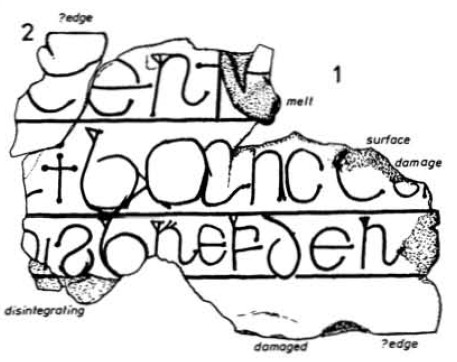
...[T]ER✝ || ... ✝BANC[E/YST]... || ...[Þ]ISBREFDER...
...ter, ban-cyst ..., þis brefde R... (reading by Elisabeth Okasha)
"... coffin (lit. bone chest), ... R. wrote this"
According to Professor Okasha, the closest epigraphic analogy with our gold strip is a lead plate from Flixborough that has the names of seven individuals inscribed on it, which was probably attached to a box containing the bones of these individuals, as must also have been the case with the Kirkdale lead plate. As both the Flixborough and Kirkdale lead plates would have been attached to an ecclesiastical 'bone-chest' containing the bones of monks and abbots, it can reasonably be assumed that the inscriptions on the plaques were engraved by monks who were accustomed to writing and copying manuscripts, and so used the same Insular half-uncial letters for the lead plate inscription as they did for manuscript writing. Of the stone inscriptions, at least the Trumbert Shaft from Yarm was also carved by a monk. Clearly the Staffordshire Hoard gold strip would not have been attached to a coffin, but these examples do suggest to me that it would have had an ecclesiastical origin, an impression that is strengthened when look more closely at the gold strip inscription.
The letterforms of the gold strip inscription are quite typical of surviving Insular half-uncial manuscripts of the late 7th through early 9th centuries, and although the letters are not so neat as those found in fine Gospel manuscripts, and lacking rule lines they tend to undulate somewhat, they are still very much comparable to the Insular half-uncial letters used in the Book of Kells and the Lindisfarne Gospels. The only slightly untypical feature of the letters is the use of an 'open e' letter rather than the normal 'closed e' letterform, but this is not necessarily diagnostic as it may either hark back to the earlier uncial 'open e' letterform or look forward to the later insular 'open e' letterform. Other features of the inscription are the letter n which occurs in both 'ɴ' and 'n' forms; the letter d which is always written with a straight back; the letter s which is written as a 'short s' except for in the partially obscured word surge where it overhangs the letter u and so must be a 'tall s' (ſ) letterform; and the word et which is written with the typical et ligature. The letters on the reverse inscription are quite similar to those on the front, although it uses the insular 'r' letterform rather than the uncial 'ʀ' letterform found on the front inscription. It is difficult to precisely date the inscription based on these features, but it does not have the high propertion of insular minuscule letters that is found in 9th century manuscripts, so it seems most likely to date to the 7th or 8th century.
The most distinctive feature of the inscription (a feature that is not present in the inscription on the reverse) is that many of the letters have open 'wedge serifs', as can be seen in the letters d, n, i, p, u, q and f :
Detail of Inscription with Wedge Serifs Coloured In

dne disepen[tur] ... qui oderu[nt] ...
Wedge serifs are a feature of the display scripts used in the highest quality manuscripts, such as the Book of Kells and the Lindisfarne Gospels (look at the ascenders of the letters b, d, h and l, and the letter u) :
Lindisfarne Gospels folio 143 (Gospel of St. Luke)
Insular half-uncial display script with wedge serifs
Some of the letters on the Kirkdale lead plate shown above also have open wedge serifs (b, f and r), but they are smaller and less conspicuous than those on the gold strip (I have not been able to find an image of the Flixborough lead plate, but Okasha notes that the letters of the Flixborough inscription do not have the same 'open serifs' that our gold strip has). The open wedge serifs on the Kirkdale lead plate and the Staffordshire Hoard gold strip appear to deliberately mimic the wedge serifs in manuscript letters, but the gold strip inscription exaggerates the serifs so that they are far more prominent than the wedge serifs seen in manuscripts. The reason for this could be that they copy a manuscript model that had enlarged open serifs that were coloured in for use as decorative display letters, similar to the coloured-in letters seen on the incipit pages of Gospel manuscripts (see Lindisfarne Gospels folio 211 below). However, I cannot find any manuscript examples that show coloured-in wedge serifs, so another possibility may be that they are an epigraphic innovation, and were intended to be inlaid with coloured enamel. Either way, the epigraphic style of the letters on the gold strip are based on and show an understanding of the manuscript tradition, and in my opinion would have been engraved by a monk at a monastic centre.
4. An Ornamental Initial from the Cover of a Gospel Book ?
The key to understanding the purpose of the gold strip is, I believe, a curious and very distinctive design that is engraved at one the end of the strip (on the reverse side as well as on the front side) :
Design at the End of the Gold Strip

At first sight this design appears quite mystifying, but in fact we can see the same basic design in the ornate incipit pages of the Lindisfarne Gospels, at the tops and bottoms of the large, decorated initial letters :
Lindisfarne Gospels folio 95 (Incipit of the Gospel of St. Mark)
INITIUM in decorative capitals, with ligatured INI
Lindisfarne Gospels folio 211 (Incipit of the Gospel of St. John)
IN PRINCIPIO in decorative capitals, with ligatured INP
Although the design on the Staffordshire Hoard gold strip is very much simpler and cruder than that seen in the Lindisfarne Gospels, it shares the same stylized design of what I see as a dragon's head, with two horns, a pair of large eyes, and a forked tongue (the twirls protruding to each side of the mouth may perhaps represent smoke emanating from the nostrils) :
Comparison of Design on Gold Strip with Decorated Initials in Anglo-Saxon Gospels
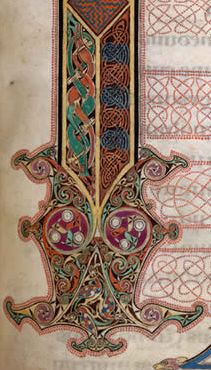
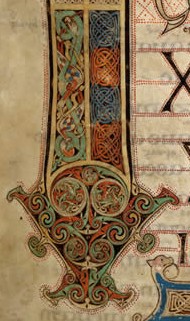

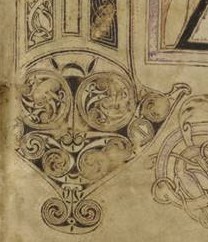
Lindisfarne Gospels on the left, Lichfield Gospels on the right
The layout of Celtic and Anglo-Saxon Gospel books of this period follows the same general pattern, and so very similar examples of decorated incipit pages can be seen on several other examples of early Gospel manuscripts, such as the Book of Kells (circa 800), the Hereford Gospels (8th century) and the Lichfield Gospels (circa 730) :
Book of Kells folio 292r (Incipit of the Gospel of St. John)
Hereford Gospels (Incipit of the Gospel of St. John)
Lichfield Gospels [The St Chad Gospels] (Incipit of the Gospel of St. Mark)
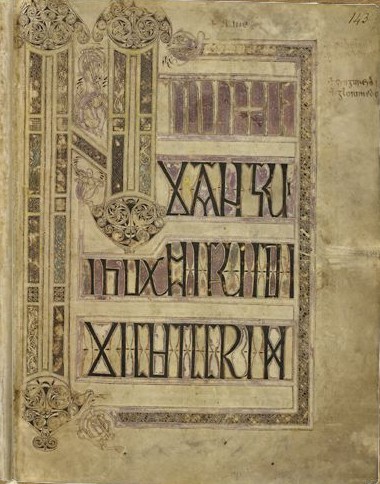
Otho-Corpus Gospels [Cotton MS Otho C.V folio 28r] (Incipit of the Gospel of St. Mark)
Burnt fragment showing INITIUM with serpentine INI
The rectagular shape of the gold strip can be seen as a reflection of the column-shaped body of the stylized dragon-creature that forms the large, decorative initial letter 'I' on the incipit pages of the Gospels of St. John and St. Mark in these books. The form of the creature that adorns the initial letters varies somewhat from book to book. Whereas the Lindisfarne Gospels and the Lichfield Gospels show a stylized dragon-like head at either end of the letter 'I', in the 8th century Hereford Gospels we see lifelike representations of a dog-like head sprouting from one end of the letter, and a lizard-like head with a pair of clawed feet emerging from the other end of the letter.
In the incipit page of the Gospel of St. Matthew in the Lindisfarne Gospels we see much more sinuous, snake-like creatures, with a head and a tail rather a double-headed body, forming the initial three letters of the word Liber, although they have the same red eyes and forked tongue that we see on the incipit pages of St. John and St. Mark. In contrast, on the corresponding page in the Book of Kells (written about a hundred years later than the Lindisfarne Gospels) the zoomorphic designs have been tranformed into purely geometric shapes, with none of the animal features seen in the Lindisfarne Gospels (four lifeless circles now take the place of the fiery eyes). The same abstraction of the original zoomorphic designs on the incipit to the Gospel of St. John can also be seen in the Book of Kells (see above).
Comparison of the Lindisfarne Gospels and the Book of Kells (Incipit of the Gospel of St. Matthew)
Liber in decorative letters
Comparing these various examples, the gold strip seems closest in design and execution to the stylized dragon heads on the initial letters 'I' and 'P' in the incipit pages of St. John and St. Mark in the early 8th century Lindisfarne Gospels and the Lichfield Gospels. We can perhaps see an evolution in the design over time, from a lifelike animal head (as seen in the 8th century Hereford Gospels) to a stylized animal head (as seen in the early 8th century Lindisfarne Gospels and Lichfield Gospels) to a purely geometric design (as seen in the late 8th century or early 9th century Book of Kells). This would tentatively suggest that the Staffordshire Hoard gold strip was based on an early 8th century manuscript model.
The similarity between the design on the gold strip and the designs on the Gospel incipit pages is to my mind evidence that the engraver of the gold strip was deliberately reworking in metal the designs used in manuscript illustration. Taken with the manuscript forms of the letters engraved on the gold strip, I think this is strongly suggestive that the gold strip was engraved by a monk who used manuscript text and illustration as his models. However, I believe that the similarity goes beyond mere stylistic influence, and points to the gold strip being actually part of the decorative tradition for Gospel book production. Manuscript books of great value, such as the Gospels, were bound with thick wooden end boards (made of a hardwood such as oak) covered in leather, and decorated with precious metalwork and jewels, emulating the decoration found inside the book.
Front Cover of the Stonyhurst Gospel (late 7th century)
This tiny Gospel book (only 12.5 cm high) was found in the tomb of St. Cuthbert in 1104, and is one of the very few surviving examples of an insular Gospel book with an intact binding. It has decorative tooled leatherwork reminiscent of manuscript decoration, but because of its size, and as it may have been the personal book of St. Cuthbert, it has none of the jewels and precious metalwork that would be expected to have adorned the covers of the great display Gospel books such as the Lindisfarne Gospels.
The colophon to the Lindisfarne Gospels indicates that the book originally had a binding created by Billfrið the anchorite that was adorned with gold and gems, but as is the case with almost all early insular Gospel books, the binding has not survived (the current silver-wrought and bejewelled treasure binding was made in 1853). The description accompanying the St Chad Gospels at Lichfield Cathedral describes its lost binding thus :
The original binding may have carried plates of metalwork, perhaps based upon the design of its carpet pages or depicting the Crucifixion and adorned with solver, gold and gems. It would have given the book an iconic function even when closed. This treasure binding was probably ripped from the book for its bullion value.
Gospels and other religious books of this period were also sometimes stored in wooden boxes, which may have been richly decorated with engraved metal plaques and jewels. A remarkably fine example of such a book box is the Stowe Bookshrine which houses the late 8th or early 9th century Stowe Missal. The front of the bookshrine has two faces, a 'lower face' dating to circa 1030 (shown below), and an 'upper face' dating to circa 1375 (here), both of which feature a large jewelled cross in the centre and four metal plaques engraved with text in Irish around the edges. The metal plaques are nailed onto the underlying oak boards of the box.
Lower face of the Stowe Bookshrine [Royal Irish Academy MS D ii 3] (early 11th century)
I believe that the gold strip from the Staffordshire Hoard was originally part of the ornamentation on the cover of a richly decorated Gospel book, or the face of a bookshrine storing such a book, as described above. The gold strip would have been rivetted onto the wooden end boards of the book or nailed into the boards of the book box, with a large jewel at the top end, and the serpent's head pointing down, forming a large decorative letter I. Given the size of the gold strip (18 × 1.6 cm) relative to the size of finely-decorated Gospel books (the Lindisfarne Gospels are 37.2 × 26.5 cm, and the Lichfield Gospels are 30.8 × 23.5 cm), the gold strip would have taken up a significant portion of the front cover, and so there would be little room for a long text attached to this golden letter 'I'. On the incipit pages of Gospel books, the large decorative letters with serpentine heads usually come in groups of three (INITIUM, IN PRINCIPIO, LIBER, QUONIAM), so it seems possible that the golden letter I may have been part of a group of three such decorated and jewelled metalwork letters. My guess is that the gold strip formed the decorative initial capital letter 'I' of the Christogram IHS at the centre of the front cover or face of a bookshrine for a large Gospel book.
5. Conclusion
Summarising the contextual, epigraphic and stylistic evidence, I think that an early 8th century date and Mercian provenance for the gold strip is most likely :
- The text of the inscription may reflect the popularity of a story about the Mercian saint, Guthlac (673–714), who is said to have exorcised British demons by singing the words from Psalm 67:2;
- The Insular half-uncial letterforms used on the inscription are typical of manuscripts and inscriptions dating from the 7th and 8th centuries;
- The decorative serpent's head on the gold strip is stylistically comparable to the manuscript decoration in the Lindisfarne Gospels (circa 715-720) and Lichfield Gospels (circa 730).
The gold strip may have formed the initial letter I of a golden, bejewelled Christogram, IHS, at the centre of the front cover of a large Gospel book or on a bookshrine holding a large Gospel book. The biblical inscription on the gold strip may reflect the importance of the cult of Saint Guthlac in 8th century Mercia, and have been engraved onto the golden I on the front cover of the Gospels in order to protect the holy book and ward off evil, directly influenced by the story of Saint Guthlac's singing of Psalm 67:2 to exorcize demons.
The fact that the hoard was discovered by the side of Watling Street just a few miles outside Lichfield, the religious centre of Mercia, makes me think that the gold strip was probably wrenched from the cover of a precious Gospel book held at the cathedral at Lichfield during the 8th century by marauding soldiers or raiders, and that they buried it and other loot when they met with opposition on the road out of Lichfield. It is even tempting to imagine that the book that the gold strip was despoiled from was the early 8th century St. Chad Gospels that has been in Lichfield Cathedral since at least the time of Bishop Wynsige (Bishop of Lichfield circa 963 to 972–5).
Given the early 8th century date of the gold strip posited above, I would suggest that a likely date for the burial of the hoard is the year 757, at which time Mercia was in a state of civil war between Offa (reigned 757–796) and the usurper Beornred following the assassination of Offa's uncle, Æthelbald (reigned 716–757).
6. Other Interesting Blog Posts about the Gold Strip and its Inscription
- The Staffordshire Hoard and Psalm 67:2... by Brandon Hawk
- Did Guthlac of Mercia bury the Staffordshire Hoard? by Jeffrey J. Cohen
- Staffordshire Hoard: Gold Strip with Old Testament Verse by Gypsy Scholar
[First published 2009-12-25, revised 2010-04-07, last modified 2015-02-06]
Index of BabelStone Blog Posts
